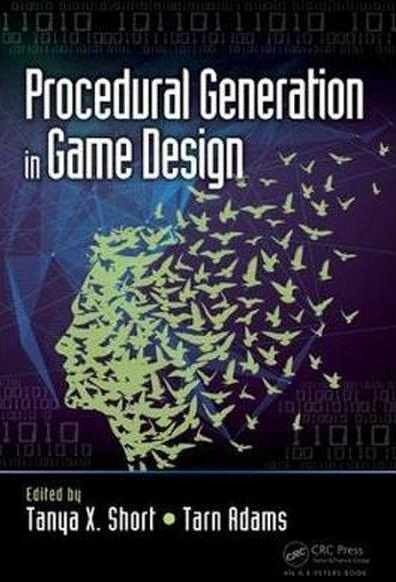From the first line of code I wrote, I have always been fascinated by procedural content generation (PCG) and the near-limitless potential it seems to hold for game development. Like so many other new developers, my first project was (of course) a wildly ambitious rogue-like. Needless to say, it didn’t quite pan out.
However, despite its challenges and limitations, I did keep my fascination for PCG and consider it a wonderful tool when applied correctly. Recently, I have been trying to read up on PCG while working on SKALD and a major gripe for me has been the lack of good literature regarding the subject. No wonder then, that I was very pleased to pick up a copy of Procedural Generation in Game Design.
Procedural Generation in Game Design is a book consisting of 27 chapters (who read like essays) from different industry professionals. The book is edited by Tanya X. Short (creative director of Kitfox Games ) and Tarn Adams (co-creator of Dwarf Fortress) with a preface by Derek Yu (creator of Spelunky) .
On its back cover, the book lists the following four features:
- Introduces the differences between static/traditional game design and procedural game design
- Demonstrates how to solve or avoid common problems with procedural game design in a variety of concrete ways
- Includes industry leaders’ experiences and lessons from award-winning games
- World’s finest guide for how to begin thinking about procedural design
The book is divided into four sections: “Procedural Generation”, “Procedural Content”, “Procedural Narrative” and “The Procedural Future”. Each section contains a collection of chapters that, more or less, share a common thread.
The topics covered in the different chapters is quite varied and include (among others): “When and Why to Use Procedural Generation”, several procedural level design case studies, “Ethical Procedural Generation”, puzzle design, “Audio and Composition”, “Story and Plot Generation” and “Algorithms and Approaches”.
Though varying in both length and depth, all the individual chapters are quite good with some even being excellent.
Mentioning a few, Mark R. Johnson’s (creator of Ultima Ratio Regnum) short chapter on meaning in PCG is great. So is Brian Bucklew’s (Freehold Games) chapter on “Algorithms and Approaches” (though I wish it had been longer). The entire section on procedural narrative is excellent as well, with the chapters by Ben Kybartas (Delft University of Technology) and Emily Short (check out her excellent blog) standing out in particular.
My major criticism of this book, however, is that it struggles in creating a coherent presentation and progression of content.
In several cases there seems to be a mismatch between chapter- and section topics. For instance: “Algorithms and Approaches” is oddly placed in the section called “Procedural Futures” even though the subject of the chapter is to give an overview of classical techniques used in PCG. In fact, I find that only the section called “Procedural Narrative” manages to maintain a strong coherency between the topics of its chapters.
As I have mentioned, I also find that the chapters vary somewhat in how deeply they explore their chosen topics. While a few read like abbreviated academic papers, others (the majority) feel more like blog posts. This is not to say that the quality of the content is poor: The chapters are written by highly talented game developers and provide inspiring insights into several well-known PCG-heavy indie game titles.
However, each chapter appears to have been written in isolation with only minimal direction concerning content. I find that the progression of content and relative amount of space given to each subject is also such that the book seems a bit underwhelming despite its 300+ pages. This is perhaps somewhat compounded by each author spending a few paragraphs talking about themselves and their project. Not that this is wrong, but it does dilute the PCG-specific content of the book.
The result is that the book does not live up to its full potential and promise of providing the “World’s finest guide for how to begin thinking about procedural design”. Furthermore I find that this makes it hard to see who the books intended audience is: New developers may find the coverage of subjects incomplete while experienced developers may find it somewhat superficial.
Though the execution is far from perfect, the book (arguably) does mostly deliver on its promised features. And for all my criticisms, I did enjoy reading the individual chapters (or essays if you will). Therefore, I do recommend picking up this book if you’re looking for an interesting collection of individual essays concerning PCG by leading indie game developers. However, if you are looking for a comprehensive guide and introduction to PCG I doubt that this book alone will suffice.
You can pick up Procedural Generation in Game Design at Amazon for $49.77 (320 pages paperback, with grey-scale illustrations).
I was tipped off about this book by the very talented Filip Hráček.
Did you find this book review helpful? If you have any questions or comments, please get in touch. Also, follow Scape-IT and SKALD on Twitter for all things RPG and geeky!



